by
Shelby Dorsey, Reporter
As 2016 begins, fresh new goals of eating healthier and going organic are surfacing. Consumers are scanning Pinterest, Facebook and Twitter for new ideas on how to be healthier, and Door to Door Organics plans on being there when they do.
Door to Door Organics is a Louisville, Colorado based company that has been gaining fans and customers as it expands its social media presence. It delivers in
15 states and 50 cities.
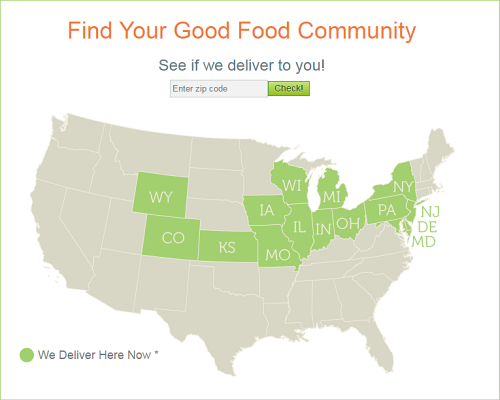
Click here to see the full version of this creative sample
The company recognized that it could use different social media platforms to further its goal of delivering "farm fresh organic produce, curated, natural, local artisan groceries … to homes, schools and offices," Cambria Jacobs, Vice President of Marketing, Door to Door Organics, said.
THE CUSTOMER
The majority of Door to Door Organics customers are women, with half having children and half being in a relationship, Jacobs said.
The company's customers also tend to be
health- and value-driven customers.
Jacobs said that organic grocery shopping represents $27 billion in a $650 billion retail grocery market, and 80% percent of those customers in the organic grocery segment are buying organic produce.
This market is rapidly growing, and Door to Door Organics would appeal to these customers — those who typically want to know where their food comes from and are interested in supporting their local markets.
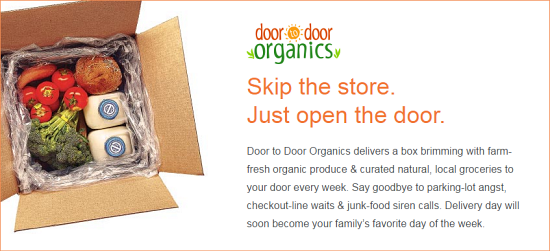
Click here to see the full version of this creative sample
CHALLENGE
Door to Door Organics found that its customers were enthusiastically sharing their experience with the brand on social media and that this was naturally creating a lot of user-generated content that the company wanted to capitalize on.
Additionally, according to Jacobs, "[Door to Door Organics'] fan base was mostly prospects and not yet customers. So we had a large audience that was listening and caring about our mission and what it was that we were doing."
A major challenge for the company, then, became converting these fans into customers.
THE CAMPAIGN
With prospects organically interacting with the company on social media, it became important for Door to Door Organics to turn this fan base into customers.
"We had a huge opportunity to engage these people and then really convert them as customers," Jacobs said.
Door to Door Organics then began to develop a social media strategy to make sure that it was "value-aligned" with what these prospects cared about "and making sure that we followed their lead versus pushing what we deemed most important."
Step #1. Identify your target audience
It is important to determine who your brand's ideal audience and target customer is so that you can plan your social media strategy accordingly.
Jacobs said that it is important to ask what social media platforms your customer is drawn to. Once you determine this — based on the platform — you can follow your customers' lead.
Door to Door Organics found its customers on Instagram and Facebook, already generating content that was there "for the taking."
This was during a time in which Door to Door Organics was looking to expand.
"Opportunity to have a new strategy was part of our launch program, by really embracing social media and bringing it in as one of our core programs," Jacobs said.
According to Jacobs, Door to Door Organics' customers had beat the company to social media and had begun to share "organically."
Be conscious of your audience
Door to Door Organics realized that many of people interacting with the brand on social media were not yet purchasing from the company.
The company, therefore, had an opportunity to engage with these prospects and convert them into being customers.
Step #2. Develop a social strategy
Once you know where your customers are engaging, it is then that you can develop a vision and a strategy, Jacobs said.
For example, Door to Door Organics has seven different Facebook communities, which Jacob said weren’t "a one-size-fits-all." This is especially true given that such a strong component of Door to Door Organics business is focused on local outreach with community farmers and food providers.
It became a priority for Door to Door Organics to "consolidate our efforts to maximize our dollars and … effort" across different social media platforms. The company began trying to determine which platforms were having the most impact and where Door to Door Organics should focus its social media efforts.
In this way, the team could move forward and adjust the brand's social media strategy accordingly.
Utilize different platforms for different purposes
Door to Door Organics realized that it saw greater rewards when it used different social media platforms for different purposes and refocused efforts in that way.
- LinkedIn — Jacobs said the company was able to focus on the B2B side of messaging and address the "business and trade" side of the business. It is also useful for recruiting new employees and for "[reaching] out to new analysts."
- Facebook — This platform is used as a type of customer service with Door to Door Organics being able to quickly respond to customers and maintain strong fan engagement. Jacobs said that, with Facebook, it is important to not be "overly aggressive," but rather stay helpful to customers. Door to Door Organics does this by not only sharing new products but also creative engagement, such as games.
- Pinterest — Pinterest helps Door to Door Organics share recipes with followers but also helps to create brand awareness.
- Instagram — The "best brand ambassadors" for the company are found on Instagram as customers share pictures of their Door to Door Organics boxes. Instagram, according to Jacobs, is a great way to visually engage with customers and leverage user-generated content.
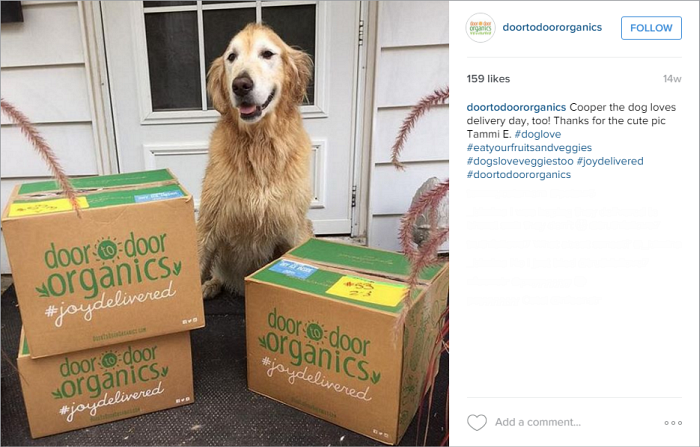
Click here to see the full version of this creative sample
Monitor the analytic capabilities of different platforms
Because Door to Door Organics utilizes so many different social media platforms, it is important to monitor the progress of all of these posts and shares to make sure that the team is truly communicating in an effective way with customers.
As each of these different platforms has ways to track customer engagement, Jacobs said that there is a dedicated social media person for the company "who helps not only drive a lot of our strategies but also helps manage our community."
For example, Facebook has analytics that allow Door to Door Organics to "identify what percentage of your customer base are on various channels."
Because the company is so focused on local communities, every region of the Door to Door Organics market has a different site. The brand has
seven different Facebook pages to help ensure that the local voice of the customer segment is maintained. Door to Door Organics has a team to help manage all of the different Facebook pages as well as local marketers that focus on the different regions.
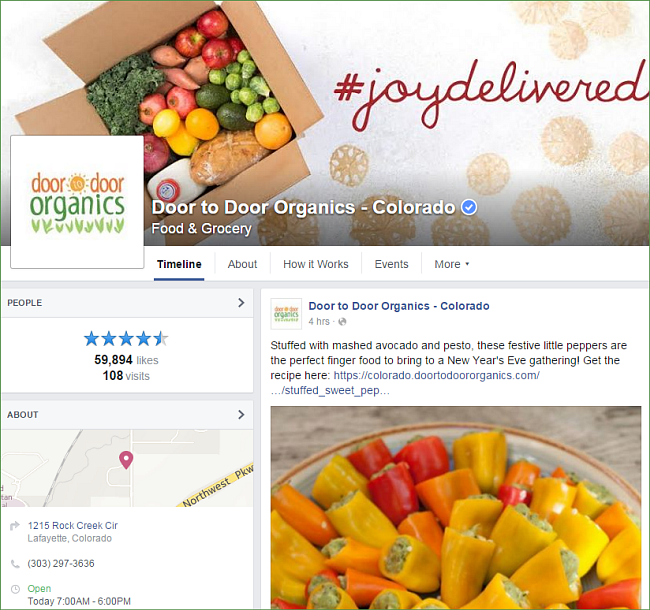
Click here to see the full version of this creative sample
Instagram makes it easy to gain customer information because they are self-sharing information about themselves and their boxes with pictures. When these consumers are posting on Instagram, they are generating content for Door to Door Organics and naturally promoting the brand.
Twitter uses hashtags that make it easy for the team to track engagement.
Step #3. Engage beyond social
Door to Door Organics has marketing separate from social that also helps to engage and convert customers. The company uses various content, fun newsletters and
farmer trading cards.
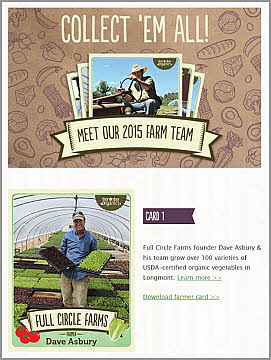
Click here to see the full version of this creative sample
An aspect of Door to Door Organics' marketing that appeals to both the promotional efforts of the company as well as appealing to its mission to empower local communities is with its farmer trading cards. The cards — similar to baseball cards — give information about the farmers who grow the food customers receive. This effort keeps consumers connected to an important part of the brand.
Many promotions run by the company involve children. Because half of Door to Door Organics' customers have kids, it is important to the brand that kids are excited about the box of organic food also.
Jacob stressed that, even with national goals for the brand, it is vital to continue to speak with a local voice. Part of maintaining this voice comes from Door to Door Organics' field marketing tactics that include event marketing and local partnership endorsements. This keeps the company connected to the communities it is working with.
RESULTS
As a result of this social media strategy and working to engage with those prospects who are not yet customers, Door to Door Organics has achieved:
- 26% new customers acquired from field marketing tactics
- 25% growth year-over-year
- In the last 24 months, a jump from 80,000 to 300,000 Facebook followers
- Since joining Instagram in 2014, gaining 8,000 followers
- Nine months on Pinterest with 4,000 followers
- Almost 4,000 Twitter followers
Jacobs said that it is important to learn from every post when a company is looking to strengthen its social media strategy and to stay connected with what is resonating with customers.
"We're just ultimately striving to be the market leader in online grocery for that health- and value-driven consumer," Jacobs said.
Creative Samples
- Door to Door Organics delivery map
- Landing page copy
- Door to Door Organics' Instagram photo
- Lafayette, Colorado's Door to Door Organics Facebook page
- Farmer trading cards
Sources
Door to Door OrganicsRelated Resources
MarketingSherpa Summit 2016 — At the Bellagio in Las Vegas, February 22-24
Inbound Marketing: Entertainment venue Topgolf increases Twitter followers 182% with relevant outreachSocial Media Marketing: When your product delights your customers, customers will help sell it [From the MarketingSherpa blog]














